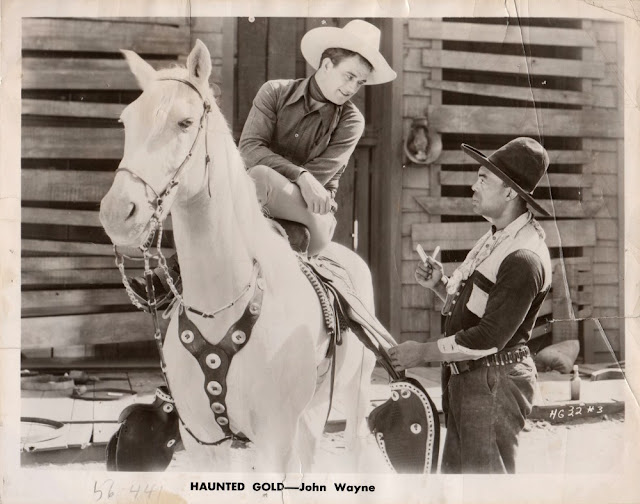Weird Westerns: Haunted Gold (1932)
★★★☆☆
A John Wayne western from before he was a star, in which he and a wonder horse must battle desperadoes at a haunted mine.
By Max Sparber
John Wayne really had two careers as a movie star. His best-known career started after he starred in "Stagecoach" in 1939, which catapulted him into a level of stardom we would now call "A-list," and it would last the rest of his life.
But before that he had been a different sort of movie star, a scrappy star of Poverty Row oaters with one major studio bomb behind him, 1930's "The Big Trail," during which he was so inexperienced at acting onscreen that director Raoul Walsh reportedly instructed him he should just sit on his horse and point.
It might be for the best that Wayne had nine-years of starring in low-budget and juvenile oaters, because it was there he turned into John Wayne. Apparently he went into acting with his swaggering walk and dragging-a-wagon line readings intact, both lifted from an actual Western legend, Wyatt Earp, who Wayne met when Earp was consulting on films and Wayne was working as a prop boy.
But it was in these Poverty Row films that Wayne developed his ability to translate that persona to screen, along with turning into a first-rate stuntman. These films may not be high art, but they were made with an exceptional verve and daring, showcasing Wayne's sardonic personality and memorable college jock physicality.
This film, as an example, introduced him riding a horse, confusingly named Duke but helpfully nicknamed "the miracle horse." Wayne comes in rollicking, playing a harmonica and bouncing gleefully along, an unexpectedly comical introduction to the character.
The film is about a haunted mine, and there isn't much to say about the plot, except that by the time this film came out the conventions of the haunted house story were already so much in place they could be plopped down anywhere, even the Wild West. So there are secret doors, panels that open to reveal watching eyes, spider web-choked rooms, and a black clad phantom that occasionally pops up to scare people.
There is also an Addam's Family-style mansion with two weirdo servants, one a mute, the other looking like a fright-wig wearing mad scientist had been pressed into service as a Butler. There is also a gang of desperadoes who are sure there is gold in the haunted mine and are determined to get it.
Wayne is equally determined he shouldn't. And while the desperadoes seem to be skilled enough to stop one irritating interloper, not only must they deal with the phantom, and John Wayne, and Wayne's miracle horse, but Wayne also has a manservant named Clarence. None of them are every where they are supposed to be, and so if the gang catches one, another will stumble along in a few minutes to free them.
About Clarence: He is played by the Negro league baseball player Blue Washington, and he deserved better. He plays a role often relegated to Black actors in this sort of film, the "feets don't fail me know" frightened black man, and he's the brunt of some openly racist humor. There's a lot in this film that is still enjoyable, but Washington's role isn't among them.
However, much of the film is given over to action, and it is dazzling: Fishtights in mining carts hung by wires above cliffs, harrowing climbs up rickety mine shafts, an actual duel between a horse and a desperado, and a climactic scene in which Wayne fights multiple men on a wagon that is racing along at a dead heat while Duke the Miracle Horse races to his rescue, also at a dead heat.
These scenes are, frankly, terrifying, especially knowing that safety standards back then were almost nonexistent, and stunt men got work based on their willingness to put themselves in real jeopardy. None of the ghostly stuff is scary; it's hokey instead.
But the action scenes? Your heart will be in your throat.



Comments
Post a Comment